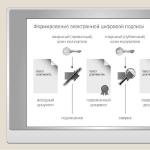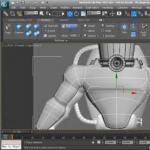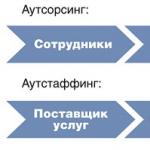Order system of ancient Greece presentation. Order system of temples Architecture of Ancient Greece Fine arts Teacher: L. V. Kukareva. The Ionic order was lighter, more elegant, more elegant
The material contains theoretical and historical information about the main five Greek and Roman orders, colorful illustrations, illustrative examples and knowledge testing. The presentation is compiled in accordance with the topics of the lessons according to the program of B.M. Nemensky art 5-9 grades.
Download:
Preview:
Accompanying sheet for the presentation
The presentation “Order system” was compiled for 8th grade students in accordance with the topics of the lessons according to the program of the author B.M. Nemensky “Fine arts grades 5-9”, Moscow “Bustard”, 1998. This presentation can also be used in extracurricular activities in ISO, MCC, technology.
- Presentation “Order system”
- Architectural orders are an order, a system of load-bearing and load-bearing elements (supports and beams) on which the entire structure rests
- The emergence of the order system influenced the diversity of architectural structures and made it possible to use rules in construction - Canons
- Doric order- his artistic image is distinguished by simplicity and masculinity
- Looking at many buildings Ancient Greece, we pay attention to the magnificent colonnades. The order is the structural basis of the building. The formation of the order system originates from the appearance of architecture itself; in the construction of temples, the order system acquired a visible image, splendor and beauty. The entablature is divided into an architrave (lower main beam), frieze (middle part) and cornice (upper part). Frieze Doric order decorated with metopes with sculpted bas-reliefs
- Ionic order- personifies the image of a beautiful, mature woman, the expression of her grace and beauty
- The Ionic order is distinguished by lightness, harmony, and grace. The capital of the Ionic order is decorated with curls reminiscent of a woman's hairstyle. In the gradation of severity and lightness, it occupies a middle position between the stronger Doric and more slender and lighter Corinthian orders.
- Corinthian order- a later style, more decorative, the lightest and most slender of the orders of the Greek system
- A column with flutes (longitudinal grooves) in the upper part has a capital, and the base of the column rests on the base. The column trunk narrows upward. The Corinthian frieze is decorated with decorative garlands
- Tuscan order- the most durable and heaviest of the orders of the Roman system. The form of the Tuscan order is borrowed from Etruscan architecture, hence its name.
- The Tuscan order was given a place on the ground floor, where it visibly demonstrated resistance to the weight lying above. The Tuscan order has no special decorations, is heavy and durable in appearance
- Composite order- the lightest and most slender of all orders of the Roman system
The capital of the composite order is supplemented with four Ionic currencies. Its proportions coincide in all respects with the Corinthian order
Slide 1
Slide 2
 About the Greek house of the 6th and 5th centuries. BC. little is known. We know that it had very modest dimensions and a simple design. Several rooms where they cooked, dined, washed and slept surrounded a courtyard through which the rooms were illuminated. In state rooms, the floors were often decorated with mosaics; utensils, especially ceramic vases, were distinguished by their exquisite forms and fine painting. All achievements of ancient Greek architecture are associated with the construction of temples. The Olympian gods, wise and perfect, must also have worthy homes - temples. Residential buildings (even of the richest townspeople) were fragile and modest. Residential architecture
About the Greek house of the 6th and 5th centuries. BC. little is known. We know that it had very modest dimensions and a simple design. Several rooms where they cooked, dined, washed and slept surrounded a courtyard through which the rooms were illuminated. In state rooms, the floors were often decorated with mosaics; utensils, especially ceramic vases, were distinguished by their exquisite forms and fine painting. All achievements of ancient Greek architecture are associated with the construction of temples. The Olympian gods, wise and perfect, must also have worthy homes - temples. Residential buildings (even of the richest townspeople) were fragile and modest. Residential architecture
Slide 3
 The temple, dedicated to the patron god of the city, was built with money from the city-policy and belonged to the entire community. Nominally remaining the dwelling place of God, it served the earthly public purposes: was a repository of the city treasury and artistic values. The temple was built on the highest place, usually on the acropolis, dominating the city buildings, in the center of the city square, which served as a place for public meetings, festivals, and religious processions.
The temple, dedicated to the patron god of the city, was built with money from the city-policy and belonged to the entire community. Nominally remaining the dwelling place of God, it served the earthly public purposes: was a repository of the city treasury and artistic values. The temple was built on the highest place, usually on the acropolis, dominating the city buildings, in the center of the city square, which served as a place for public meetings, festivals, and religious processions.
Slide 4
 HOMEWORK Write down the meaning of the terms in a notebook and indicate in the figure: Entablature - Base - Architrave - Frieze - Cornice - Metope - Flutes - Pediment - Triglyph -
HOMEWORK Write down the meaning of the terms in a notebook and indicate in the figure: Entablature - Base - Architrave - Frieze - Cornice - Metope - Flutes - Pediment - Triglyph -
Slide 5
 TYPES OF GREEK TEMPLES Temple in Antes Prostyle Amphiprostyle -peripter -dipter -false peripter (double peripter) (Roman)
TYPES OF GREEK TEMPLES Temple in Antes Prostyle Amphiprostyle -peripter -dipter -false peripter (double peripter) (Roman)
Slide 6
 Temple of Poseidon at Paestum The classic, most common type of Greek temple was the peripterus (which means “feathered”) - a rectangular temple surrounded on all sides by columns. An example of such a temple is the Temple of Poseidon in Paestum. Plan of a Greek temple. Peripter.
Temple of Poseidon at Paestum The classic, most common type of Greek temple was the peripterus (which means “feathered”) - a rectangular temple surrounded on all sides by columns. An example of such a temple is the Temple of Poseidon in Paestum. Plan of a Greek temple. Peripter.
Slide 7
 A – Doric, B – Ionic, C – Corinthian. The numbers show the parts of the order: 1 – cornice, 2 – frieze, 3 – architrave (cornice, frieze and architrave together form an entablature), 4 – capital, 5 – column trunk, 6 – base.
A – Doric, B – Ionic, C – Corinthian. The numbers show the parts of the order: 1 – cornice, 2 – frieze, 3 – architrave (cornice, frieze and architrave together form an entablature), 4 – capital, 5 – column trunk, 6 – base.
Slide 8

Slide 9
 As a result of the long evolution of the temple, an architectural system was formed, later called the order (which means “order”). An order is a system of relationships between the columns (load-bearing part) and the entablature (bearing part). PARTS OF THE ORDER AT TOP: ARCHITRAVE FRIEZE CORNICE form ENTABLEMENT
As a result of the long evolution of the temple, an architectural system was formed, later called the order (which means “order”). An order is a system of relationships between the columns (load-bearing part) and the entablature (bearing part). PARTS OF THE ORDER AT TOP: ARCHITRAVE FRIEZE CORNICE form ENTABLEMENT
Slide 10
 a column placed on a base or without a base, standing on a stylobate (top slab of a stone base); the column is decorated with a capital, on which rests a load-bearing beam - an architrave, which, together with a decorative frieze and cornice, forms an entablature. The Greek architectural order consisted of the following elements:
a column placed on a base or without a base, standing on a stylobate (top slab of a stone base); the column is decorated with a capital, on which rests a load-bearing beam - an architrave, which, together with a decorative frieze and cornice, forms an entablature. The Greek architectural order consisted of the following elements:
Slide 11
 DORIC ORDER In the archaic era, the order developed in two versions: Doric and Ionic. Temple of Athena at Paestum. Built around 570. The Doric order developed in the Peloponnese and in the Greek colonies of Sicily and southern Italy.
DORIC ORDER In the archaic era, the order developed in two versions: Doric and Ionic. Temple of Athena at Paestum. Built around 570. The Doric order developed in the Peloponnese and in the Greek colonies of Sicily and southern Italy.
Slide 12
 DORIC ORDER The Doric peripter stood on a stone base - a stereobat (usually of three steps). The column, decorated with vertical grooves - flutes, did not have a base; it was completed by a simple round pillow with a square slab above it. According to the Greeks, the Doric order is the embodiment of the idea of masculinity, severity, and simplicity. The columns of Doric temples were subsequently often replaced by male figures (Atlantes).
DORIC ORDER The Doric peripter stood on a stone base - a stereobat (usually of three steps). The column, decorated with vertical grooves - flutes, did not have a base; it was completed by a simple round pillow with a square slab above it. According to the Greeks, the Doric order is the embodiment of the idea of masculinity, severity, and simplicity. The columns of Doric temples were subsequently often replaced by male figures (Atlantes).
Slide 13
 IONIC ORDER Caryatids of the Erechtheion Temple The Ionic order became most widespread in Asia Minor and on the islands of the Aegean Sea. The shaft of the Ionic column was originally thinner than that of the Doric column, confirming its origin in wood construction. An Ionic column has a base. Temple of Nike Apteros
IONIC ORDER Caryatids of the Erechtheion Temple The Ionic order became most widespread in Asia Minor and on the islands of the Aegean Sea. The shaft of the Ionic column was originally thinner than that of the Doric column, confirming its origin in wood construction. An Ionic column has a base. Temple of Nike Apteros
Slide 14
 IONIC ORDER The Ionic order was lighter, more elegant, and more elegant. The slender colonnade had a base at the base and was decorated with a capital in the form of two graceful curls, which are called volutes. Columns of the Ionic order were often replaced by female figures (caryatids).
IONIC ORDER The Ionic order was lighter, more elegant, and more elegant. The slender colonnade had a base at the base and was decorated with a capital in the form of two graceful curls, which are called volutes. Columns of the Ionic order were often replaced by female figures (caryatids).
Slide 15
 CORINTHIAN ORDER In the classical era, a third order was developed - Corinthian, close in proportions to the Ionic, but even more slender and festive.
CORINTHIAN ORDER In the classical era, a third order was developed - Corinthian, close in proportions to the Ionic, but even more slender and festive.
Slide 16
 CORINTHIAN ORDER By the end of the 5th century. BC. a third architectural order arose, Corinthian. Its columns are as graceful as those of the Ionic order, and its entablature is more magnificent. The Corinthian capital resembles an inverted bell, composed of two rows of acanthus leaves with spiraling vine tendrils at the corners.
CORINTHIAN ORDER By the end of the 5th century. BC. a third architectural order arose, Corinthian. Its columns are as graceful as those of the Ionic order, and its entablature is more magnificent. The Corinthian capital resembles an inverted bell, composed of two rows of acanthus leaves with spiraling vine tendrils at the corners.
Slide 17

Slide 18
 HOMEWORK: The Greek architectural order found application not only in ancient architecture, but also became the main element of the architecture of the Renaissance, Baroque, and Classicism. WRITE IN THE TABLE IN YOUR NOTEBOOK THE HISTORICAL BUILDINGS YOU KNOW WITH THE GREEK ORDER SYSTEM ON THE LEFT AND THE YEAR OF CREATION ON THE RIGHT.
HOMEWORK: The Greek architectural order found application not only in ancient architecture, but also became the main element of the architecture of the Renaissance, Baroque, and Classicism. WRITE IN THE TABLE IN YOUR NOTEBOOK THE HISTORICAL BUILDINGS YOU KNOW WITH THE GREEK ORDER SYSTEM ON THE LEFT AND THE YEAR OF CREATION ON THE RIGHT.
Slide 19
 Son of Kronos and Rhea. Lord of the gods, progenitor of gods and people. Temple of Zeus at Olympia IDENTIFY TEMPLE TYPE AND ORDER Temple of Zeus at Olympia, built between 468 and 456 AD. BC. architect Libo, had the significance of a pan-Hellenic sanctuary and was the largest temple in the entire Poloponnese. The temple is almost completely destroyed, but based on excavations and descriptions of ancient authors, its general appearance can be fairly accurately reconstructed.
Son of Kronos and Rhea. Lord of the gods, progenitor of gods and people. Temple of Zeus at Olympia IDENTIFY TEMPLE TYPE AND ORDER Temple of Zeus at Olympia, built between 468 and 456 AD. BC. architect Libo, had the significance of a pan-Hellenic sanctuary and was the largest temple in the entire Poloponnese. The temple is almost completely destroyed, but based on excavations and descriptions of ancient authors, its general appearance can be fairly accurately reconstructed.
The purpose of the lesson: introduce students to the order system, prove that the basis of the cultural achievements of antiquity is love for man.
Tasks:
- expand students’ understanding of the role and contribution to the culture of the Ancient Greeks;
- to develop in schoolchildren comparison skills and the ability to highlight the main thing;
- expand students' thesaurus by introducing new terms and concepts;
- motivate children to further independently become acquainted with the elements of the architectural decoration of cities.
Lesson type: explanation of new knowledge.
- Hello guys!
Today in class we continue the conversation about the amazing and still mysterious Ancient Greece for us. It is no secret that it was this era - the era of antiquity, being an example of the inner and outer beauty of a person, that first showed the world what heights a person can achieve. Therefore, as the epigraph for our lesson, I took Protagoras’ aphorism “Man is the measure of all things.” Guys, how do you understand these words?
(Students' opinions are listened to.)
– These words are carved on the pediment of the temple in Delphi and, it seems to me, correspond to the entire architecture of Ancient Greece, the main feature of which was organicity and proportionality to man.
So, as you may have guessed, today in the lesson we will look at the architecture of Ancient Greece, namely the order system: we will get acquainted with three types of orders and see how the ancient order reflected the fundamental essence of ancient art - its focus on man. Open your notebooks, write down the date and topic of the lesson.
Guys, for many hundreds of years, Greek architects developed every element of the building. The result of their work was the creation of an order system, the main form of which is a column. Remember what a column is? You can refer to dictionaries. (Column(French) - a building element, a support, usually of round or square cross-section, supporting a beam, entablature or arch heel)
– The column with all its details, as well as the parts located above and below the column, form a single whole and its construction is subject to a certain rule and order. The order is named by the Latin word "ORDO". Hence the name "ORDER SYSTEM", an architectural order.
The main Greek orders - Doric, Ionic and Corinthian - were not formed immediately (see. Annex 1
).
At the end of the 7th century BC, the Doric system appeared, its name comes from the names of one of the most important Greek tribes - the Dorians, who lived in the Peloponnese, Sicily and the southern part of the Apennine Peninsula. The Dorians were distinguished by their special courage and severity. Let's see how the character traits of the Dorians, their courage, firmness, and resilience were reflected in architecture. What do you think was the main focus in such a column? Does it have decorative elements? (The main attention was paid not to decorative elements, but to the strict beauty of the lines.)
– Pay attention to the capital – this is the name of the upper final part of the column. Describe it based on the illustration and slide of the Doric column of the Temple of Hera at Paestum. (The column is distinguished by its simplicity, special solemnity, has no base, and grows directly from the foundation.)
– Guys, pay attention to the handouts (see. Appendix 2 ). Let's read the text and answer the question: what did the ancient Greeks take as a basis when creating the Doric column? (The Doric column reproduces the proportions of the load-bearing part of the male body 1:5.)
List of references:
1. Vardanyan R.V. World artistic culture: Architecture. – M.: Humanite. ed. VLADOS center, 2003.– 400 p.
2. Postnikova T.V. Antiquity. Popular science edition for children. – M.: Publishing House “ROSMAN-PRESS” LLC, 2002. – 127 pp. – (History of art for children).
3. Lisichkina O.B. World artistic culture: Renaissance: Part 2, book 2: Textbook. A manual for high school general education. Institutions. – M.: Astrel Publishing House LLC, 2001. – 304 p.
4. Ryabtsev Yu.S., Kozlenko S.I. History of Russian culture: XVIII–XIX centuries. – M.: Humanite. ed. VLADOS center, 2001. – 320 p.
5. Rapatskaya L.A. Russian artistic culture. Textbook manual for university students. – M.: Humanite. ed. VLADOS center, 2002.– 608 p.
6. Lvova E.P., Fomina N.N., Nekrasova L.M., Kabkova E.P. World Art. From origins to the 18th century. (Essays on history). – St. Petersburg: Peter, 2006. – 416 p.
7. Encyclopedia for children. Volume 21. Society. Part 2. Cultures of the world. - Chief. ed. E. Ananyeva; Ved. ed. M. Boyarsky. – M.: Avanta +, 2004. – 640 p.
8. Encyclopedia for children. Additional volume. Russian capitals. Moscow and St. Petersburg. Head ed. V.A.Volodin.– M.: Avanta +, 2001. – 448 p.
9. Temples. Monasteries. The most beautiful and famous. Ved. ed. E. Ananyeva; resp. ed. T. Kashirina.– M.: Avanta +, 2003.–184 p.
10. Locks. Palaces. The most beautiful and famous. Ed. group: E. Ananyeva, T. Evseeva, E. Dukelska.– M.: Avanta +, 2005.– 184 p.
11. 100 magnificent cathedrals of the world. The greatest treasures of mankind on five continents. Translated from German - M.: LLC "World of Books", 2004. - 2008 p.
12. St. Petersburg. Album. Ed. M. Lyzhenkova.– St. Petersburg: "P-2", 1998.
The purpose of the lesson: introduce students to the order system, prove that the basis of the cultural achievements of antiquity is love for man.
Tasks:
- expand students’ understanding of the role and contribution to the culture of the Ancient Greeks;
- to develop in schoolchildren comparison skills and the ability to highlight the main thing;
- expand students' thesaurus by introducing new terms and concepts;
- motivate children to further independently become acquainted with the elements of the architectural decoration of cities.
Lesson type: explanation of new knowledge.
- Hello guys!
Today in class we continue the conversation about the amazing and still mysterious Ancient Greece for us. It is no secret that it was this era - the era of antiquity, being an example of the inner and outer beauty of a person, that first showed the world what heights a person can achieve. Therefore, as the epigraph for our lesson, I took Protagoras’ aphorism “Man is the measure of all things.” Guys, how do you understand these words?
(Students' opinions are listened to.)
– These words are carved on the pediment of the temple in Delphi and, it seems to me, correspond to the entire architecture of Ancient Greece, the main feature of which was organicity and proportionality to man.
So, as you may have guessed, today in the lesson we will look at the architecture of Ancient Greece, namely the order system: we will get acquainted with three types of orders and see how the ancient order reflected the fundamental essence of ancient art - its focus on man. Open your notebooks, write down the date and topic of the lesson.
Guys, for many hundreds of years, Greek architects developed every element of the building. The result of their work was the creation of an order system, the main form of which is a column. Remember what a column is? You can refer to dictionaries. (Column(French) - a building element, a support, usually of round or square cross-section, supporting a beam, entablature or arch heel)
– The column with all its details, as well as the parts located above and below the column, form a single whole and its construction is subject to a certain rule and order. The order is named by the Latin word "ORDO". Hence the name "ORDER SYSTEM", an architectural order.
The main Greek orders - Doric, Ionic and Corinthian - were not formed immediately (see. Annex 1
).
At the end of the 7th century BC, the Doric system appeared, its name comes from the names of one of the most important Greek tribes - the Dorians, who lived in the Peloponnese, Sicily and the southern part of the Apennine Peninsula. The Dorians were distinguished by their special courage and severity. Let's see how the character traits of the Dorians, their courage, firmness, and resilience were reflected in architecture. What do you think was the main focus in such a column? Does it have decorative elements? (The main attention was paid not to decorative elements, but to the strict beauty of the lines.)
– Pay attention to the capital – this is the name of the upper final part of the column. Describe it based on the illustration and slide of the Doric column of the Temple of Hera at Paestum. (The column is distinguished by its simplicity, special solemnity, has no base, and grows directly from the foundation.)
– Guys, pay attention to the handouts (see. Appendix 2 ). Let's read the text and answer the question: what did the ancient Greeks take as a basis when creating the Doric column? (The Doric column reproduces the proportions of the load-bearing part of the male body 1:5.)
List of references:
1. Vardanyan R.V. World artistic culture: Architecture. – M.: Humanite. ed. VLADOS center, 2003.– 400 p.
2. Postnikova T.V. Antiquity. Popular science edition for children. – M.: Publishing House “ROSMAN-PRESS” LLC, 2002. – 127 pp. – (History of art for children).
3. Lisichkina O.B. World artistic culture: Renaissance: Part 2, book 2: Textbook. A manual for high school general education. Institutions. – M.: Astrel Publishing House LLC, 2001. – 304 p.
4. Ryabtsev Yu.S., Kozlenko S.I. History of Russian culture: XVIII–XIX centuries. – M.: Humanite. ed. VLADOS center, 2001. – 320 p.
5. Rapatskaya L.A. Russian artistic culture. Textbook manual for university students. – M.: Humanite. ed. VLADOS center, 2002.– 608 p.
6. Lvova E.P., Fomina N.N., Nekrasova L.M., Kabkova E.P. World Art. From origins to the 18th century. (Essays on history). – St. Petersburg: Peter, 2006. – 416 p.
7. Encyclopedia for children. Volume 21. Society. Part 2. Cultures of the world. - Chief. ed. E. Ananyeva; Ved. ed. M. Boyarsky. – M.: Avanta +, 2004. – 640 p.
8. Encyclopedia for children. Additional volume. Russian capitals. Moscow and St. Petersburg. Head ed. V.A.Volodin.– M.: Avanta +, 2001. – 448 p.
9. Temples. Monasteries. The most beautiful and famous. Ved. ed. E. Ananyeva; resp. ed. T. Kashirina.– M.: Avanta +, 2003.–184 p.
10. Locks. Palaces. The most beautiful and famous. Ed. group: E. Ananyeva, T. Evseeva, E. Dukelska.– M.: Avanta +, 2005.– 184 p.
11. 100 magnificent cathedrals of the world. The greatest treasures of mankind on five continents. Translated from German - M.: LLC "World of Books", 2004. - 2008 p.
12. St. Petersburg. Album. Ed. M. Lyzhenkova.– St. Petersburg: "P-2", 1998.
To use presentation previews, create a Google account and log in to it: https://accounts.google.com
Slide captions:
Greek order The word “order” comes from the Latin ordo – “in order”, “as it should”. The Greek order is one of the historical forms post-beam system in architecture.
Already in Ancient Egypt, massive pillar-columns supported beams lying on them.
The structure of posts and a beam lying on them is natural for wooden construction.
It was during the construction of wooden structures that the main parts of the order were formed.
Stereobate column Entablature Pediment Stylobate Column trunk Capital Architrave Frieze Cornice Metope Triglyph Main parts of the Greek order
The origin of the name of the parts of the Greek order Stereobates is from the Greek. "stereos" - strong and "bates" support. Column - from lat. "columna" - column. Entablature - from Greek. “ante” - straight and “blemma” - look. Pediment - from lat. “Frons” - forehead, face. Stylobate - from Greek. "stylos" - rod, column and "bates" - support. Capital - from Lat. "caput" - head. Architrave - from Greek. "archi" - main and "trabs" - beam. Frieze - from Greek. “Frisso” - trembling, trembling. Metope - from Greek. "metopon" - front side. Triglyph - from Greek. “try” - three and “glypho” - cut out. Cornice - from Greek. "koronis" - completion.
Try to find the main parts of the order in the photo of the Parthenon. ? ? ? ? ? ? ?
Along with working on the simplicity and clarity of the design, Greek architects worked hard on the visual impression of the building. The same structure, such as a post and beam, can look different depending on the design. These visible structural changes are called tectonics.
Let's follow the tectonic changes in the support.
The design of a simple pillar and a column is the same, but their tectonic (visual) solution is different. This is how an architect uses tectonics to achieve different effects with the same design.
Column trunk Capital Base Abacus Volutes Echin Abacus Flutes Using these details, the tectonic expressiveness of the column is achieved.
The column trunks were carefully measured, hewn from separate stone blocks, right down to the flutes, and fastened together with tenons.
However, the main thing in the order is not the sequence of parts of the building, but their clear correlation with each other, their proportionality. It is proportions that distinguish one order from another.
1 1 1 16 18 20 1 3/2 2 1/3 1 1 1/4 1 1/2 1 1/2 1 1/2 1 1/2 1 1/2 1 3/4 2 Proportions of Greek orders Module (unit measurements) – column diameter.
The proportions of the Doric order make it massive and heavy. It is no coincidence that Doric temples were called “male” temples.
This impression is helped by the very simple structure of the top of the column - the capital.
The Parthenon is the most famous Doric temple of antiquity.
Temples of the Ionic order are more slender and elegant. It is no coincidence that they said that their columns have feminine proportions.
The capital of the Corinthian column, like a whimsical hairstyle, is decorated with acanthus leaves.
In the era of classicism (XVIII-XIX centuries), buildings were largely built on the basis of the order.





